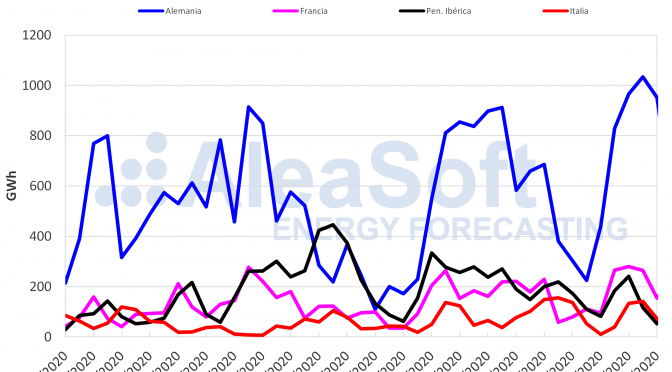Earlier this week, on March 2, Spain’s wind energy production set the 2020 record so far with 366 GWh. The increase in wind power production led to the fall in MIBEL market prices, which has been positioned since that day with the second lowest price in Europe, something that is usually unusual. In the rest of the European markets, the general trend was the increase in prices due to lower temperatures and lower wind and solar production.
Solar photovoltaic and solar thermal production, wind production and electricity demand
Solar production declined in most European electricity markets so far this week compared to last week’s average. In Italy the week began with a low production that was recovering in the following days, but still the decrease with respect to the average of the week of February 24 was 18%. In the French market, production decreased slightly during this half of the week, falling 18% on average, while in the Iberian Peninsula the fall was 29%. The German market was the only one in which solar production increased between Monday and Wednesday of this week, positioning 27% above the average production last week.
In most markets, total solar production from March 1 to 4 decreased year-on-year, except in Germany where it increased by 90%. The most notable falls were 31% in Italy and 21% in France.
In AleaSoft, this week’s solar production is expected to increase in Germany compared to that of the week of February 24 and decrease in Spain and Italy.
Source: Prepared by AleaSoft with data from ENTSO-E, RTE, REN, REE and TERNA.
Source: Prepared by AleaSoft with data from ENTSO-E, RTE, REN, REE and TERNA.
Wind production in European markets had ups and downs during the first three days of this week compared to the average values ??of last week. On the one hand, it decreased by 59% and 47% in Germany and France respectively. Whereas, in the Iberian Peninsula and Italy it had corresponding ascents of 44% and 14%, including a record for 2020 of maximum daily production of 452 GWh in the Iberian Peninsula on March 2.
During the first four days of February, wind production recorded year-on-year increases in some markets of the continent, and falls in others. In Germany and France the declines were 29% and 22% respectively. On the other hand, in the Iberian Peninsula and Italy the increases were 114% and 65%.
In AleaSoft, this week’s wind production is expected to be lower than last week in most of the markets analyzed, except in the Iberian Peninsula where it will continue to be higher at the end of this week.
Source: Prepared by AleaSoft with data from ENTSO-E, RTE, REN, REE and TERNA.
The electricity demand increased from March 2 to 4 evenly in the European electricity markets compared to the same period last week, except in the German market where it fell 0.8%. In Portugal, the rise was 12% due to the effect of the carnival Tuesday holiday, held on February 25 of last week. Correcting this effect the increase in Portugal was 0.6%. The decrease of 2.1 ° C in the average temperatures during this period in one of the markets most sensitive to this magnitude, the French, caused an increase of 7.3% of the demand in this market. In the Belgian market the fall of 0.9 ° C in average temperatures led to a 2.4% increase in demand. In Spain and Italy the increase was 1.8%.
In Aleasoft it is expected that at the end of this week the electricity demand in most markets will be higher than that of the week of February 24.
Source: Prepared by AleaSoft with data from ENTSO-E, RTE, REN, REE, TERNA, National Grid and ELIA.
Peninsular Spain, renewable production
This week, the wind production of peninsular Spain reached the highest value of 2020 so far, registering 366 GWh on Monday, March 2, due to the strong winds caused by the stormy Karine. The average level of the wind generation of the first three days of this week exceeded the average of last week by 43%. From March 1 to 4, wind production doubled compared to the same period of 2019, increasing by 110%. For this week, production with this technology is expected to end up being greater than last week.
In terms of solar production, which includes photovoltaic and solar thermal, fell 30% so far this week compared to the average values ??of the previous week. Comparing the first four days of March with the same period of the previous year, the generation from this renewable source fell 1.6%.


